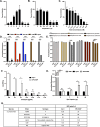SP-CHAP, an endolysin with enhanced activity against biofilm pneumococci and nasopharyngeal colonization
- PMID: 38470268
- PMCID: PMC11005408
- DOI: 10.1128/mbio.00069-24
SP-CHAP, an endolysin with enhanced activity against biofilm pneumococci and nasopharyngeal colonization
Abstract
Streptococcus pneumoniae (Spn), a Gram-positive bacterium, is responsible for causing a wide variety of invasive infections. The emergence of multi-drug antibiotic resistance has prompted the search for antimicrobial alternatives. Phage-derived peptidoglycan hydrolases, known as endolysins, are an attractive alternative. In this study, an endolysin active against Spn, designated SP-CHAP, was cloned, produced, purified, biochemically characterized, and evaluated for its antimicrobial properties. Cysteine, histidine-dependent amidohydrolase/peptidase (CHAP) domains are widely represented in bacteriophage endolysins but have never previously been reported for pneumococcal endolysins. Here, we characterize the first pneumococcal endolysin with a CHAP catalytic domain. SP-CHAP was antimicrobial against all Spn serovars tested, including capsular and capsule-free pneumococci, and it was found to be more active than the most widely studied pneumococcal endolysin, Cpl-1, while not affecting various oral or nasal commensal organisms tested. SP-CHAP was also effective in eradicating Spn biofilms at concentrations as low as 1.56 µg/mL. In addition, a Spn mouse nasopharyngeal colonization model was employed, which showed that SP-CHAP caused a significant reduction in Spn colony-forming units, even more than Cpl-1. These results indicate that SP-CHAP may represent a promising alternative to combating Spn infections.
Importance: Considering the high rates of pneumococcal resistance reported for several antibiotics, alternatives are urgently needed. In the present study, we report a Streptococcus pneumoniae-targeting endolysin with even greater activity than Cpl-1, the most characterized pneumococcal endolysin to date. We have employed a combination of biochemical and microbiological assays to assess the stability and lytic potential of SP-CHAP and demonstrate its efficacy on pneumococcal biofilms in vitro and in an in vivo mouse model of colonization. Our findings highlight the therapeutic potential of SP-CHAP as an antibiotic alternative to treat Streptococcus pneumoniae infections.
Keywords: CHAP domain; antibiotic resistance; bacteriophage; endolysin; pneumococcus.
Conflict of interest statement
The authors declare no conflict of interest.
Figures


References
MeSH terms
Substances
Grants and funding
LinkOut - more resources
Full Text Sources
Medical

